Extra Research¶
Here are experiments that I did not pursure further but have detailed the documentation anyways
Very simple DIY bioprinting¶
Recipe¶
The recipe is based of Petra's bioprinting workshop with smaller proportions.
- 0.5g degummed and shredded silk
- 2g guar gum
- 50ml water
Protocol¶
- Combine the guar gum and water to make an even paste
- Stir in the silk and try to avoid clumps
- Press the paste into a syringe and print it into whatever design you like


I made a netted circle shape to explore what silk-based biomaterial could be used for the biomateial joinery (which needs some kind of netted section to be locked between the two sides of silkworm mesh). The sample feels strong and has a nice sheen. The silk needs to be shredded into smaller and finer pieces because they form clumps in the solution. This leaves both a cosmetic problem and also makes it difficult to print thin and even lines in the syringe.
Fibroin Extraction¶
Materials¶
| Qty | Description | Price | Purchased |
|---|---|---|---|
| 1kg | Calcium Chloride | 2.80€ | |
| 1L | Ethanol | 5.40€ | Quimics Dalmau |
| 10ft | Dialisys Tubing | 14€ | Amazon |
Recipe¶
6g CaCl2 to 94g MeOH (250ml) for 0.5 g of degummed silk.
From article Dissolution behavior of silk fibroin in a low concentration CaCl2-methanol solvent.
Degummed silk fibroin was then solubilized for 50 minutes at 98°C with calcium chloride, ethanol, and water (at a molar ratio of 1 : 2 : 8). This solution was subsequently filtered for three days over dialysis membrane to obtain silk fibroin solutions.
From article Silk Fibroin: A Promising Tool for Wound Healing and Skin Regeneration
Pupa Shell Chitin Extraction¶
After all the research on the extraction process I realized the yield of chitosan would be so little with the emount of shells that I have.
Chitin is one of the most widely available and used polysaccharides found in crustacian shells, insect exoskeletons and fungi. It is the second most abundant biopolymer after cellulose. According to this article, The silkworm pupal shell contains up to 2.6–4.2% chitin and Chitosan obtained from silkworm pupae has shown good antimicrobial activity and ability to act as a hemostatic agent (surfaces that manage bleeding). Chitosan is derived from chitin by removing a sufficient number of acetyl groups (CH3–CO) for the molecule to be soluble in most diluted acids.
This Shellworks Projects shows a bit about chitin extraction from shrimp shells and the applications and home-made tools they used.
This project by Sasha Fishman details the process of extracting chitin from cicada shells, which is most likely similar to pupa shells.

Materials¶
| Qty | Description | Price | Purchased |
|---|---|---|---|
| 1kg container | Citric Acid | 15 € | Amazon |
| 1kg container | NaOH | 5 € | Quimics Dalmau |
Recipe¶
This article has a section on pupal shell chitin processing: Pupae were treated with 1N HCl at 100 °C for 20 mins and later with 1N NaOH at 80 °C for 36 to 24 hrs to obtain chitin. The chitin sample was converted into chitosan after treating with 40% NaOH at 110 °C for 4 hrs. Treated material was dissolved in 2% acetic acid and pH adjusted to 8–9 to precipitate the chitosan with 70–80% yield.
A recipe for bombyx mori pupa chitin extraction is also detailed in this article:

Protocol¶
Pulverizing
- Grind the shells into powder with a mortar and pestle.
Demineralization
- With an acid (10% citic acid can be used for this based on this study)
- Filter with a strainer and rinse the matter with water until water neutrality.
Decolorization (optional)
- Using bleach to remove any colorants.
Deproteinization
- With NaOH (sodium hydroxide "lye")
- To make 1 N solution, dissolve 40.00 g of NaOH in water to make volume 1 liter.
- Filter with a strainer and rinse the matter with water until water neutrality.
- Now you will have chitin.
Deactylate (chitin to chitosan)
- With 100g 50% NaOH per 1g chitin heat and mix 110 °C for 2 hours.
- Filter with a strainer and rinse the matter with water until water neutrality.
DIY Felting Tool¶
Felting can be done in a variety of ways: using water and rubbing by hand, using large rolling pin type machines, using modified sanding or polishing machines to rub the fibers, or with handheld needle tools, needle guns, or table top needle machines.
Resources¶
- Wine cork hand held needle tool
- Janvi Gohel Fabricademy felting tool tutorial
- Tufting gun details (which is kind of similar)
- Thingverse hand needle tools
- Sketchfab hand needle tool
Research¶
Here are two examples of felting guns that will inform my design. I have found guns for sale but no diy fabrication files for them, many of the guns are sold out or on backorder so hopefully creating this open source documentation will be helpful for others. The left is from etsy and the right from a review video on this etsy product.

It is also interesting to see these innovations in felting for larger architecture purposes. On the left is a project using a robotic 3d felting machine. And on the right is a project from Bartlett making chairs from a fabric composite.

Also this study on robotic felting wool to bond other materials
Materials¶
| Image | Qty | Description | Price | Link |
|---|---|---|---|---|
 |
5 | Felting Needles | 12,00 € | x |
 |
1 | Moter | x | x |
 |
1 | Power Switch | x | x |
 |
1 | Potentiometer | x | x |
 |
1 | Rubber Band | x | x |
Sketching and Measuring¶

Parts I need to 3d print:
- Handle
- Barrel/motor holder
- Gear 1
- Gear 2
- Needle holder part 1
- Needle holder part 2